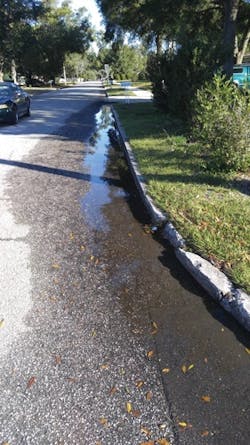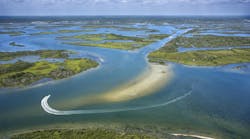About the author: Deodat Budhu, P.E., is manager, roads and drainage division, for Orange County, Fla. Budhu can be reached at [email protected] or 407.836.7919.
The lack of gutters and inlets contributes to the frequent issue of standing water in the roadways.
The retrofit of older subdivisions typically is challenging due to the need to overcome boundary conditions, such as outdated drainage systems with limited amounts of infrastructure, and soil and groundwater issues.
Long-Distance Drainage
One of these typical old neighborhoods is the Southwood subdivision in Orange County, Fla. With more than 19 streets covering a cumulative linear length of approximately 27,000 ft, the roadways throughout the Southwood subdivision are defined by concrete curb (no gutters) and limited storm inlets that convey the pavement surface drainage into an underground storm sewer system. Therefore, in most of the areas, storm water runoff from this subdivision generally has to flow long distances along the streets before it can discharge to the storm water system.
The roadside landscaped areas are higher than the roadways, by more than 1 ft in several areas. In addition, lawns within the subdivisions are reasonably well maintained and irrigated; therefore, excessive irrigation together with surface water drainage problems manifests into pavement deterioration.
Following the completion of a new gravity sewer rehabilitation and water system improvements construction project within the subdivision, staff observed localized surface water ponding, saturated soil conditions and premature pavement distress. While it is not clear if the root cause of the problems was related to the water and sewer rehabilitation project, it appeared that the pavement resurfacing associated with that project may have slightly changed the profile, eliminating several of the valley gutters and/or reducing storage within the pavement limits, which is enough to cause the nuisance ponding.
In addition, the new gravity sewer rehabilitation work could have lowered the soil permeability in some areas, which can aggravate subsurface drainage and cause saturation and seepage. Moreover, the repaving may have increased the pavement elevation, which reduces the capacity of the primary drainage conveyance.
Based on the detailed field evaluation of the pavement conditions and hydraulic modeling of the surface flow, the following were the prognosis:
- The paving project raised the roadway grades, reducing the net storage within the conveyance.
- The paving project grades were not inclined to provide natural and continuous flow of runoff and surface water flow, but rather created localized depressions without outlets to prevent adverse pooling.
- Water seeped over the curb as a result of an apparent perched water table that develops from two sources: heavy surface infiltration/irrigation of the pervious surface of the surrounding lot and water entry of the pavement/gutter interface that is inundated for extended periods by the slow and deep gutter flow.
- The minor pavement defects were a result of the soil surface generated from excessive irrigation surcharge and lateral water intrusion under the curbs. The roadway base is sound.
The recommended retrofit involved installing additional drainage inlets, adding underdrains to selected areas, re-profiling the roadway asphalt surfaces through resurfacing, reconstructing the valley gutters at intersections to provide position conveyance and constructing flumes at the eventual outfall to the canals.
Retrofit of older subdivisions can be challenging, as every site is unique and using the same approach for each is not always practical.
Standing Water
Other older subdivisions in the area, such as Meadowbrook and Lake Sparling Heights, have curb and gutter roadway sections and adequate drainage in those areas, but slightly different issues. Half the roadways within these subdivisions do not have a formal drainage system, and runoff primarily flows through the roadway along upright (Type D) curbs.
However, past repaving efforts and driveway improvements have left the pavement overbuilt and uneven in some areas. This is especially evident in newer driveways that have been raised to the current (higher) pavement elevation. Because of the uneven elevation between the pavement and driveways, as well as the lack of gutters and inlets, standing water in the roadways is a frequent issue, and the resurfacing of these roadways without addressing the drainage/ponding situation would not be prudent. Therefore, a partial solution involving re-profiling the roadway through repaving was sought.
To accurately depict these locations, a digital terrain model of the roadways was created based on the results of a laser scanner survey. The scanner provides an accurate description of the roadway topography and supplies a large amount of survey data to help spot elevations that are important to identify and address the standing water issues. Several profiles then were created for each road to evaluate the existing topography of the pavement and ribbon curb. Profiles were prepared for the center line, as well as the edge of the pavement and the top of the curb along both sides of each road.
The design solution includes creating new profile grade lines for the full length of both the left and right sides of the roads at the edge of pavement. The retrofit crown of the road would have varying cross slopes ranging from 1% to 4% cross slope. Proposed roadway elevations would also correspond as much as possible to current driveways. The existing upright curb would remain in place, paying particular attention to the top of the curb profiles to ensure the new edge of the pavement is not raised above the curb.
Although this approach could save the replacement of some driveways, it would become challenging to the paving crew, as the resurfacing process would have to be slow to enable design success from the digital terrain model. This would result in a change of scope and higher price for the resurfacing efforts and, therefore, is not cost-effective. The best approach to solve this drainage challenge is to revert to valley gutters in the affected intersections to convey the flow to the few inlets in the area, and add inlets and pipes. Despite the delay in time to have this construction done, and knowing that after the regular resurfacing is done a few more driveways would have to be reconstructed to match the new pavement elevation, the desired resolution of the ponding issue and the realization of a more cost-effective option was worth it.
As evidenced by these two cases, the retrofit of older subdivisions can be challenging, as every site is unique, and using the same approach for each is not always practical. However, lessons learned from each situation can be used as guidance for resolution of future drainage issues.


